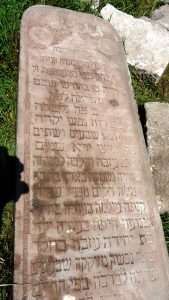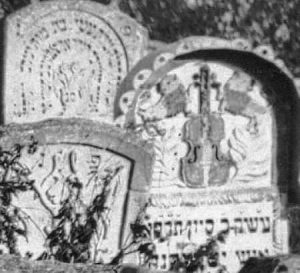![]() Ця сторінка також доступна українською.
Ця сторінка також доступна українською.
“Carved tombstones are one of the most notable expressions of traditional Jewish art. This form of artistic creativity belongs to the past: examples are found throughout the Diaspora, and it attained a particularly high level of development in the Pale of Czarist Russia and in Galicia. The gravestones of Ukraine and Moldova, two regions formerly within the Pale and now independent countries, are especially noteworthy for their decorative quality and inventive figurative design.”
– David Goberman, from the introduction to Carved Memories: Heritage in Stone from the Russian Jewish Pale
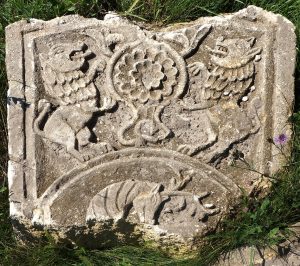
Broken and stolen from Rohatyn’s old Jewish cemetery decades ago, now unearthed, recovered and returned, this matzevah fragment is an outstanding example of the symbolism in the stones. Photo © 2016 Alex Denysenko.
Our page on Jewish Traditions for Death, Burial, and Mourning introduces many of the customs associated with Jewish cemeteries and grave markers, and provides links to a number of external references on the worldwide Jewish rituals and practices of burial and remembrance. A matzevah (Hebrew מצבה, a Jewish grave marker; plural matzevot) is both a memorial and a puzzle, carrying historical information as well as literary and sculptural artistic value. Here we use some of the many examples of Jewish grave markers in Rohatyn to help explain and celebrate the art and meaning of our surviving heritage. For this topic, we borrow heavily from an excellent article by Marcin Wodziński in the online YIVO Encyclopedia of Jews in Eastern Europe (linked in the sources at the bottom of this page), reordered and selected to focus on the history and practices in the sub-region around Rohatyn; our extensive text selections from the YIVO article are shown in italics here. For several topics, especially on symbolism in the figurative art, we have gathered information from other sites and books (also listed among our sources below); significant among the online resources are articles and photo galleries written and assembled by Ruth Ellen Gruber for the Jewish Heritage Europe portal and the (Candle)sticks on Stone website. Importantly, we have used photographs of Rohatyn’s two Jewish cemeteries and the large number of gravestones there (a few standing, but most gathered and recovered in fragments as part of our Jewish Headstone Recovery Project); every photograph on this page was taken in Rohatyn. The rich stock of visual examples in Rohatyn is a treasure to us, and we hope it will be to others as well. To quote from YIVO:
In Eastern Europe today there are several million extant Jewish tombstones, often removed from their original locations and often severely damaged. Despite increasing interest, the subject is still very poorly researched; only a handful of individual cemeteries have been inventoried or systematically documented and studied. Professional documentation of Jewish tombstones in Eastern Europe is a singularly urgent task, given the rapidly progressing devastation of these tombstones due to both vandalism and atmospheric pollution.
History to the 17th Century
East European Jewish tombstones follow the Ashkenazic pattern that was developed in Central Europe from the eleventh to the fourteenth century. Their most typical traits include vertical position (as opposed to Sephardic tombstones, which usually lie horizontally), rectangular shape, and the prominence of inscription fields.
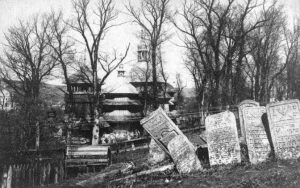
Rohatyn’s old Jewish cemetery in an undated pre-war photograph. Public domain; image acquired by Hershel Schwartz from the New York Public Library for the RDRG.
Jewish sepulchral traditions in Eastern Europe [began] to develop [in] the thirteenth century. In Poland […] the oldest surviving Jewish tombstones date from the sixteenth century. It is possible that earlier ones have not been preserved. The [surviving early] tombstones are rendered in the style already typical of late-medieval Ashkenazic sepulchral forms: they are upright, level rectangular slabs, the only decorative elements of which are flat fascia bordering the inscription field.
This type of tombstone predominated in all of Eastern Europe until the second half of the sixteenth century, and in more remote localities until the beginning of the seventeenth. The most interesting and largest groups of gravestones of this type, dating from the second half of the sixteenth and the beginning of the seventeenth centuries, are preserved in Busk near Lwów (from 1520), Lublin (1541), Szczebrzeszyn (1545), Lesko (1548), and Buczacz (1587).
Epitaphs from this period contain the basic elements of the formulas that characterized later inscriptions, although individual elements of the epitaph (opening formula, closing formula, information block) had at this point not yet been entirely differentiated. The lettering recalls versions of bookhand-style lettering with a significant difference in thickness between horizontal and vertical lines; the inscription is always engraved. These tombstones possess no essential characteristics that would differentiate them from [contemporary] Central or West European models.
Jews were recorded as settling in Rohatyn by 1564, and were given municipal rights to build a cemetery in 1633, just in time to participate in newly-developing regional traditions for Jewish cemetery art.
Matzevah Materials
Throughout [the first centuries of Jewish settlement in Eastern Europe], and most notably until the nineteenth century, the most common material for tombstones was undoubtedly wood. Grave markers were simple planks with painted inscriptions or images of full-size gravestones carved into the wood. Given the material’s lack of permanence, very few of these have survived. Of the tombstones that have survived, the overwhelming majority are carved in stone, although a few nineteenth-century and early twentieth-century examples made of cast iron have also endured, as well as some twentieth-century ones composed of artificial stone (terrazzo, concrete). The most commonly preserved tombstones are thus not representative of East European Jewish sepulchral art in its entirety; rather, they are more typical of the sepulchral art of the wealthier classes, as stonework was expensive until the nineteenth century. Traditional tombstones were often covered with paintings, scarcely preserved to this day.
The vast majority of surviving grave markers in Rohatyn’s old and new Jewish cemeteries are cut from soft limestone, but a smaller number include pink sandstone, grey granite, and other materials. We have not yet found any examples of concrete grave markers which may have been used in either Jewish cemetery in the years before the Shoah. In contrast, there are pre-war concrete markers in Rohatyn’s Christian cemetery, so we may recover concrete matzevot in the coming years.

Some of the variety of materials used in matzevot in the Rohatyn Jewish cemeteries. Shown here are old and new markers made of limestone, pink sandstone, grey granite, and stuccoed brick. Photos © 2011, 2014, 2015 Jay Osborn and © 2016 Alex Denysenko.
Design and Composition
The sixteenth century saw the development of a school of sepulchral stonemasonry of high artistic value and very particular local traits. Sixteenth-century tombstones from Prague – as is the case with those found in large Jewish communities in Poland or even in provincial centers such as Chęciny or Pińczów that had a highly developed artistic culture – embodied a Renaissance (and later Baroque) aesthetic, incorporating classical architectural motifs to enrich the composition of the face of the tombstone.
In the mid-seventeenth century, this type of tombstone spread throughout the region, at the same time undergoing “primitivization” and a rapid evolution toward folk art forms. The folk version of this type of gravestone, sometimes referred to as Jewish Baroque, became the best-known type among East European Jewish communities; it predominated until the mid-nineteenth century and – in many localities in Ukraine, eastern Poland, and Belorussia – as late as the Holocaust. The inscription field continued to be the most prominent element in a tombstone of this style, but the composition of the front of the stela changed under the influence of contemporary architectural models – as seen, for instance, in the motif of the arcade, the aedicula and, from the early seventeenth century, a notable tendency toward dividing the front of the stela into clearly differentiated parts: a pediment, a framed inscription field, and a base. Initially the pediment contained the opening formula of the inscription (or at least part of it), but from the late seventeenth century on it was more and more often filled with ornamental and symbolic images; at the same time, the pediment itself grew larger. An extreme example of this tendency can be seen in the gravestones of eighteenth- and early-nineteenth-century southeastern Poland, Ukraine, and Moldavia, where the pediment, richly ornamented and filled with symbolic motifs, constituted almost half of the tombstone, and the main principle of its composition seems to have been “horror vacui”.
Design of Rohatyn Matzevot
The many matzevot found in Rohatyn’s Jewish cemeteries – whether standing, fallen or recovered, and whether intact or fragmentary – follow the Ashkenazic pattern described above: originally standing vertical, more tall than wide, generally rectangular slab shapes, and presenting a large field for memorial inscriptions.
Few of the matzevot that exist today in Rohatyn are as originally designed and carved; nearly all are broken and missing important parts. The few intact survivors are made mostly of harder materials (sandstone or granite) and date from the late 19th century through the 1930s. Given the long history of Jews in Rohatyn, these intact survivors thus do not represent the full range and diversity of designs, styles, and materials which existed in Rohatyn over the centuries. From a handful of less-intact older and softer stones, and larger fragments now recovered to the old Jewish cemetery, we can conclude that Rohatyn’s Jewish dead were memorialized in the primary styles described by YIVO, whether as a simple text field with borders, or as text surrounded by ornament and topped with a decorated pediment. The skills of the stone cutters and carvers did not appear to factor in the choice of design; we have found both coarse and fine examples of each. All of the matzevot included a blank base of 50~100cm height which was anchored in the cemetery soil.
Although the damage done to the majority of the stones precludes a comprehensive catalog, a number of the stones retain their original top edge curves and allow a simple survey of the variety of outline designs. A small number of the surviving upper sections are square-cornered; many more are formed as semicircles or smaller (flatter) circle segments. A few take oval or more complex architectural forms. Shoah memorial markers erected in the cemeteries by Jewish descendants since Ukrainian independence reflect the traditional forms. Curiously, to date in Rohatyn we have recovered no examples with beveled, fan, or triangular top edges, as are seen in some intact cemeteries elsewhere in East Central Europe.

Examples of the shapes and composition of standing and fallen matzevot in the Rohatyn Jewish cemeteries. Shown here are old and new rectangular markers with a variety of top edge curves. Photos © 2011, 2012, 2015, 2016 Jay Osborn and © 2016 Alex Denysenko.
The repertoire of motifs employed to decorate tombstones included ornamental architectural elements as well as perhaps 100 symbolic, figurative motifs, often tied together in stylized, complex, and very specialized compositions. Examples of these specialized hieratic schemes include crowns flanked by heraldic lions or deer, the pitcher and bowl of Levite tombstones, professional symbols (such as the caduceus often seen on physicians’ graves), and family symbols.
Ornamental Architectural Elements in Rohatyn Matzevot
Many of the Rohatyn grave markers, even those in small fragments, show some architecture-inspired decoration, usually in the panel borders, supporting the pediment, or at the base. In our ongoing work, we have documented a few examples with arcades, many with columns, several with draperies (especially surrounding candelabra, discussed below), and a number of fragments with faux brickwork. These elements serve to frame both the text panels and the figurative motifs.
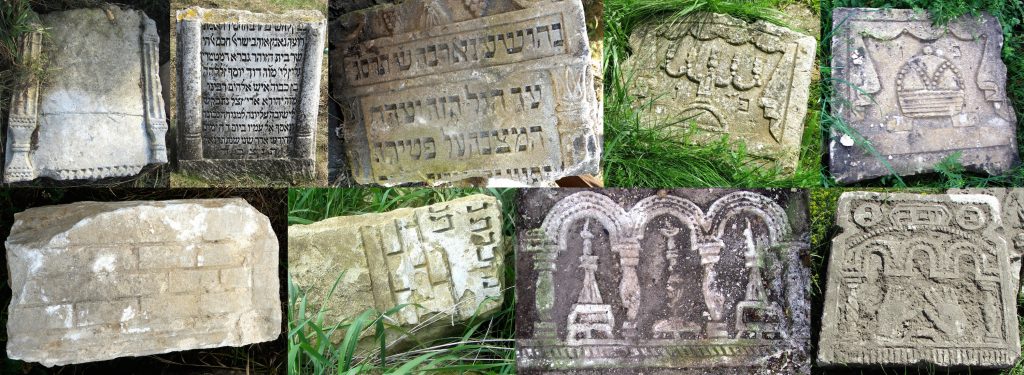
Several examples of stylized architectural elements in Rohatyn matzevot. Top row, left to right: two pairs of columns with missing pediments; columns with intact lintel; two forms of draperies framing other figurative elements. Bottom row, left to right: two sets of faux brickwork; two arcades on columns framing other figurative elements. Photos © 2011, 2012, 2014, 2015, 2016 Jay Osborn, © 2016 Olga Verbiana, © 2016 Tom Traber.
Symbolic Elements: Crowns
The crown as a symbol is associated with royalty, and by extension was often used as a sign of high status and honor for the deceased in any of several domains. Inspiration for using this symbol on matzevot comes from the Talmud saying, “There are three crowns–the crown of Torah, the crown of priesthood and the crown of sovereignty – but the crown of a good name surmounts them all.” So it could represent honor in deeds, e.g. the “crown of Torah study” (keter torah), or the crown of priestly service and blessing (keter kehuna). But perhaps it most often represented the “crown of a good name” (keter shem tov), for a highly-regarded person. The crown was also sometimes used as as a sign that the deceased was the head of a household. Crowns appear on Rohatyn grave markers in a variety of styles.

Crowns in several styles at the top of Rohatyn matzevot, all clearly visible despite the damage and decay in the stone. Photos © 2012, 2013, 2014 Jay Osborn, © 2016 Marla Raucher Osborn, © 2016 Alex Denysenko.
Symbolic Elements: Lions
Lions are another symbol associated with royalty, and they appear on many Rohatyn matzevot. Lions are usually shown in pairs, often flanking another symbol (often a crown), the introductory acronym of the epitaph, or, on later stones, a Magen David (Star of David). The animals may be either facing each other or facing away from each other, and often their tongues are extended; their tails are typically entwined around their legs or other features of the design. The Lion of Judah, a common graphical motif in Jewish art, is associated with the Tribe of Judah, from a reference in Genesis 49:9, and was used on some matzevot to refer to the name of the deceased (as Yehuda in Hebrew). Given names which mean or refer to “lion” could also inspire the use of the symbol, including Aryeh, Ari, or Ariel in Hebrew, Leib in Yiddish, Löb or Loeb in German, Lew in Polish and related Slavic cultures, and variants of Lev and Leo in several languages.

Lions with crowns (top row), and lions without (bottom row); a selection of lions depicted on Rohatyn Jewish gravestones. The distinctive stylized depiction of lions makes it possible to identify them even in small fragments. Photos © 2011, 2012, 2014, 2015 Jay Osborn and © 2016 Alex Denysenko.
Symbolic Elements: Other Animals
Stone carvers in Rohatyn had a large repertoire of symbols to draw from to illuminate the epitaphs of the deceased on their matzevot. Because depicting people was traditionally prohibited in Jewish law, images of animals stood in to provide clues to the names, personal traits, and character of the dead. Symbolic meaning which was obvious to the relatives and associates of the deceased, but is now mysterious to modern interpretation, can be a fascinating object of study.
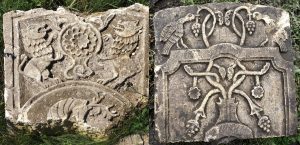
Less common animals on Rohatyn matzevot: left, a deer (with a pair of lions); right; a pair of birds. Photos © 2016 Alex Denysenko and @ 2016 Jay Osborn.
In addition to the lions shown above, in surviving regional Jewish cemeteries one can find:
- wolves: related to the Yiddish names Wolf and Velvel, and the Hebrew names Ze’ev/Zev and Benjamin
- bears: the name Dov
- deer: the names Zvi and Hirsch
- birds: the woman’s names Feigl and Cipora, and also used to indicate charity or action
- fish: the name Fischel, or may indicate a death by drowning
Inspiration could come from many sources. A frequently quoted saying is from the Talmud, Pirkei Avot 5:23: “Be strong as a leopard, light as an eagle, swift as a deer, and mighty as a lion to do the will of your God in heaven.” Less majestic or even mythical animals were also used, often with now-cryptic meaning: rabbits or hares, sheep, sometimes unicorns.
Only a few examples from this repertoire have yet been found in Rohatyn. Two beautiful stone fragments are shown here: the head, antlers and neck of a deer (together with lions), and a pair of birds biting grapevines. The significance of the grape bunches and vines may be related to wealth (especially spiritual), but further explanation of the stones is not yet possible: for each example the rest of the matzevah with the name, dates, and descriptive epitaph is still missing.
Symbolic Elements: Candelabra and Candlesticks
The matzevah design motif most tied to religious symbolism is that of the menorah, or candelabrum, which refers variously to the legendary lamp stand erected by Moses in the wilderness, to the light in the Temple of Jerusalem, and significantly in cemeteries, to female virtue. The menorah has been a symbol of Judaism since ancient times, as an image of wisdom or universal enlightenment. Candelabra are often depicted with seven branches, following the design described in Exodus 25:32 and alluding to both the traditional seven branches of human knowledge and the seven days of creation. On grave markers recovered in Rohatyn, many examples have only five branches, and some depict individual candlesticks rather than a candelabrum.
In the cemetery, these symbols usually indicate the grave of a woman. The connection is through the weekly tradition wherein a woman of the household lights the evening candles which usher in the Jewish sabbath; in a typical celebration, the woman lights the candles, waves her hands over them, covers her eyes, and recites a blessing. Lighting the Shabbat candles serves two purposes: to honor Shabbat, and to promote domestic peace. Traditions related to sabbath candles and the importance of women initiating Shabbat date to Sarah, the wife of the patriarch Abraham.
Many of the Rohatyn matzevah candelabra are quite ornate, with curved and looping arms, but some are strikingly modern and angular. Usually only the stand and candles are depicted, but in a few examples the flame is also visible.

Some of the many styles of candelabra on Rohatyn matzevot. At lower left, a rarer example of single candlesticks. Photos © 2011, 2012, 2015, 2016 Jay Osborn and © 2016 Tom Traber.
Symbolic Elements: Blessing Hands
Another striking religious symbol is the blessing hands of the Jewish kohanim (priests), traditionally the descendants of Aharon, the first high priest and older brother of Moses. The role of kohanim in religious services changed after the destruction of the Second Temple, but they remain significant in both practical and symbolic functions. Kohanim participating in Orthodox prayer services deliver the nesiat kapayim (priestly blessing through lifting of the hands) of Numbers 6:24~27 during the standing prayer of the Amidah. During the blessing, the priest raises his hands, with the left and right thumbs touching, and spaces spread between the thumb and first finger, and between the second and third fingers, on each hand. Each hand in this position thus forms the Hebrew letter ש (shin), representing Shaddai, the Almighty God. In this service, the hands of the priest are the vehicle for God’s blessing of the praying Jews.
On grave markers, the symbol of the blessing hands may indicate that the deceased was a kohain, or descendant of Aharon, or someone with the very common related surname (Cohen and its many variations) regardless of their religious or blood connection to the priestly order. So far we have recovered only two intact examples of the blessing hands in Rohatyn, plus one worn but mostly intact example, and one fragment showing only a few fingers of the right hand.

The priestly blessing in Rohatyn matzevot. Photos © 2016 Olga Verbiana, © 2016 Alex Denysenko, and © 2012 Jay Osborn.
Symbolic Elements: Pitchers
There have been more examples recovered in Rohatyn of another religious symbol, the pitcher or ewer of the Levites. At least five versions are seen on Rohatyn matzevot, with a few other possible examples we are unable to verify because too much of the symbol is lost.
Traditionally members of the Israelite Tribe of Levi, the Levites were responsible for specific political and religious duties in Jewish civil and spiritual life. One branch of the Levites are the kohanim, described above. Those Levites who are not kohanim had other duties, including singing and playing music in the temple, and serving as guards. But the task most closely associated with non-kohain Levites, and memorialized on grave markers, is the ritual washing of the hands of the kohanim before the priestly blessing. The water pitcher (or jug, or cup) used for this honorable task became the symbol for the group, and the symbol was used on matzevot for people associated with the descendants of Levi, or anyone with a given name or surname of Levi or its variants. In Rohatyn, we have not yet found examples seen in some other cemeteries of the region, such as a hand holding the pitcher, or water pouring from it, but a few of the Rohatyn images include a basin below the pitcher.
Other Design Features
The range of prominent symbols on Jewish grave markers in east central Europe is very broad, only a portion of which is found on matzevot recovered so far in Rohatyn. But there are many other conspicuous design features and decorations on the grave markers in Rohatyn’s two Jewish cemeteries.
Even matzevot which were not originally designed with figurative artwork often have decorative borders around the epitaph field; most are geometric, but some borders are carved as palm fronds, grapevines, or other plants. Trees and flowers appear as both central features and as decorative borders. Circular emblems in the form of flowers or sunbursts appear both centrally and at the corners of the stones. On the smaller recovered fragments, often it is these carefully-carved details which are our first clue that the stone is part of a matzevah and not ordinary building material, no matter what purpose the stone may have served since WWII.

A small sample of the variety of design and decorative elements on Rohatyn matzevot. Photos © 2011, 2012, 2014, 2016 Jay Osborn and © 2016 Alex Denysenko.
The development of this style of tombstones in eastern Poland, Ukraine, Moldavia, and Belorussia in the eighteenth century resulted in a growing divergence between the eastern and western parts of East Central Europe. In western Poland, Silesia, and Bohemia, tombstones began to resemble Christian sepulchral art, and in some areas the influence of high-art styles—Baroque, rococo, and, later, classicism—was notable.
In the nineteenth century, the style of more traditional East European sepulchral art also evolved. From the beginning of the nineteenth century, vanitative symbolic elements of non-Jewish origin (e.g., hourglasses, butterflies, pommels, or poppies) became increasingly common.
In the nineteenth and twentieth centuries sepulchral art underwent a further evolution, moving even closer to Christian artistic traditions. In western regions, historical styles came into widespread use, with obelisks, columns, fully three-dimensional statuary, and larger architectural structures becoming popular, while traditional Jewish symbolism all but disappeared.
During the interwar period even the most traditional Jewish communities in Eastern Europe were inundated by prefabricated tombstones, resulting in a marked deterioration in Jewish sepulchral art. Nor was this art reborn after the Holocaust.
Ohels and Other Grave Covers
In addition to simple vertical slabs, pseudosarcophagi were popular in some localities in the sixteenth through the eighteenth centuries. Beginning in the eighteenth century, some tombs of exceptional scholars, rabbis, or holy men were built with an “ohel” (literally, tent), a simple structure covering the grave.
In Rohatyn’s old Jewish cemetery, near the top of the slope at the east end, an Israeli Hasidic organization working in central and eastern Europe built a new ohel in 2011 over the 19th-century graves of three Rohatyn rabbis of the Stratyn Hasidic dynasty: Rabbi Uri Langner and his sons Rabbi Yehuda Tzvi and Rabbi Yitzchak Aaron. The new ohel replaced a structure which had been lost decades earlier. Until then, the graves of these rabbis were still covered, but the covers had been in poor condition.
At the other end of the old cemetery in Rohatyn, one other horizontal grave cover survives among the fallen, upright, and recovered matzevot. No markings have yet been found on this cover; it awaits further research.

Unusual grave markers in Rohatyn’s old Jewish cemetery. Left to right: the grave covers of three prominent rabbis; the new ohel built over their graves in 2011; installation of the matzevah of one of the rabbis recovered by Rohatyn Jewish Heritage; the remaining horizontal grave cover among fallen matzevot. Photos © 2011, 2012, 2014 Jay Osborn.
Languages and Lettering in Epitaph Inscriptions
Until the nineteenth century, all tomb inscriptions were written in Hebrew (with some Aramaic barbarisms in the epitaphs of learned elites), although many betray poor knowledge of the language. Hebrew inscriptions were written in square script. Cursive and semi-cursive script began to appear sporadically only in the sixteenth and seventeenth centuries, and were used for the closing formula (or some part thereof) of the epitaph.
[From the mid-seventeenth century,] the inscription field was often filled with ornamented epitaphs done in relief script, with much variation in the height and style of the letters, and flanked by various sorts of ornamental fringe, pilaster strips (lisene), pilasters, or demicolumns. The epitaph formula was also elaborated, with laudatory and elegaic sections enriched by poetic elements, frequently with rhyming verse (initially monorhymes, then geminate, cruciform, and encircling in form), acrostics, or chronograms. Stylistically, folk literature with its bead-string structure predominated as a model, in the elite version suggestive of biblical figures of speech and employing citations from and allusions to the Bible. More commonly, however, the epitaphs were quite simple, often with spelling and grammar mistakes, using very simple forms and a limited repertoire of formulas. The largest and most remarkable collections of tombstones of this sort are preserved in Sataniv, Międzyboż, Sieniawa, and Lesko.
Hebrew Lettering Examples on Rohatyn Matzevot
Although the lettering on the majority of recovered grave markers in Rohatyn’s Jewish cemeteries is incised, there are many examples with carved relief script as well, which can be found on both standing and fallen stones. Many of the incised matzevot show layout marks scratched into the stones by the carver, as a guide for cutting the letters in the common Hebrew book-hand style with much heavier horizontal lines than vertical; some more worn stones show a faint hint of these layout marks as well, and others are so worn that even the letters’ vertical lines are lost. Overall the variety of lettering examples is very broad, both in style and in quality, and in some examples the text overlaps with figurative and decorative elements. Even the older matzevot, with no other design elements than text, still have a monumental quality simply from the weight and block style of the Hebrew characters.

Hebrew lettering examples on Rohatyn matzevot. In the first row at left are a few examples of raised lettering; elsewhere the examples are incised, some still retaining the stone carvers’ guide marks. At right in the third row are a few examples of worn lettering, now difficult to read. Photos © 2011, 2012, 2014, 2015, 2016 Jay Osborn and © 2016 Olga Verbiana.
Blending Art with Purpose: the Epitaph Opening
A very common formula for a Jewish epitaph in the region began with a standard opening, passing sometimes through brief or lengthy epithets characterizing the deceased, proceeding through his or her title and given name, their paternal lineage and sometimes also their surname (or if the deceased was a woman, the name of her husband), then their date of death, and ending finally with a standard closing. The opening and closing phrases were so formulaic that they were usually abbreviated, as were many of the common phrases elsewhere in the epitaph. Together with the wear and damage seen on the recovered stones, these abbreviations can make a full reading of the epitaphs difficult today, even when the full text has survived.
The epitaph closing was almost always the five-letter acronym תנצבה of the Jewish farewell blessing תהא נפשו/ה צרורה בצרור החיים, t’hay nafsho/ah tzrurah b’tzror hachaim (“may his/her soul be bound in the bond of life”, sometimes “eternal life”), a blessing which remains in wide use today.
The epitaph opening was nearly always an abbreviated form of “here lies”, whether פ”נ or simply פ נ (peh nun, PN), standing for poh nitman/nitmenah (or poh nikbar/nikberah, “here is buried”). A much less common variant form, mostly used for deceased women, translates more poetically as “here lies hidden”, using the letters פ”ט or פ ט (peh tet, PT), standing for poh tamun/temunah. A few other variants are also occasionally seen, sometimes in less abbreviated forms.
The depiction of the abbreviated epitaph opening on a grave marker was an opportunity for the stone carver to demonstrate his mastery of the art, and to create variety in the designs he contributed to a cemetery. The two characters פ נ were frequently arranged as elements of the matzevah pediment and separate from the rest of the epitaph in placement and style. Sometimes the treatment of the opening characters was the only design departure from plain text and borders on the entire stone.

Some of the many examples of the epitaph opening abbreviation פ נ in the Rohatyn Jewish cemeteries. Photos © 2011, 2012, 2013, 2014, 2015 Jay Osborn, © 2016 Alex Denysenko, @ 2016 Marla Raucher Osborn, and © 2016 Tom Traber.
In the nineteenth century, inscriptions grew increasingly formulaic, stiff, and segmented. The number of available symbolic motifs gradually decreased; at the same time, however, there was a loosening of hieratic symbolic compositions, as a result of which symbols were composed more freely and new compositions of a narrative character began to appear. With the spread of mechanical stoneworking, ornamental plane lettering was replaced by typographic styles, while relief inscriptions gave way to sunken lettering.
At the same time in the west, German or bilingual (German and Hebrew) inscriptions became widespread, initially written in Hebrew letters, later also in the Latin alphabet. In the twentieth century, German inscriptions became prevalent, while some tombstones had the date of birth indicated by an asterisk (that is, the Christian symbol of the star of Bethlehem), and the date of death, by a cross. Similar, though not quite so radical, tendencies were visible throughout nineteenth- and twentieth-century Eastern Europe, above all in large urban areas such as Warsaw, Łódź, or Lwów, where various sepulchral art traditions commingled. The first Polish epitaph is found in Warsaw, inscribed on the grave of Antoni Eisenbaum in 1855.
Later Language Examples on Rohatyn Matzevot
Inscriptions in Polish and German also appear on matzevot surviving in or recovered to both of Rohatyn’s Jewish cemeteries. In each case, the information is limited to the deceased’s name, birth and death dates, and in one case, his profession. The Polish or German inscription always appears on the reverse side of the matzevah; usually a longer Hebrew epitaph appears on the front side. All of these examples date from the 1930s, in the interwar period when Rohatyn was under Polish rule. The German language epitaph seen here probably reflects the residual connection between Rohatyn Jews and the Austrian Empire which had vacated Galicia only two decades earlier.

A few examples of matzevot with epitaphs in European languages from both Rohatyn Jewish cemeteries. Photos © 2011, 2012 Jay Osborn.
During the interwar period, the trends toward incised lettering and away from sculptural decoration (in part prompted by the use of harder stone materials) also contributed to a reduction in the length of epitaphs on many matzevot, but some continued in the lengthy and flamboyant style of earlier years, including poetry and acrostics. A complete pink sandstone tombstone recovered from under vul. Drahomanova in Rohatyn in 2016 is a good example: the epitaph begins with four lines identifying the deceased woman by name and lineage, and the date of her death:
Chana, daughter of the esteemed deceased,
our exceptional teacher Yitzchak Tzvi Nagelberg,
may his memory be for a blessing,
passed away on the 26th of the month of Shevat 5695 [1935]
The inscription goes on to describe Chana in poetic text, with the first letter of each line spelling out her name:
wise of heart, buried here
humble, dear soul
was 75
daughter of a G-d fearing man
departed and left for her [eternal] rest
[may] her soul be bound in the blessed land
had mercy on the poor with the fruit of her hand
acquired her [portion of] the world [to come] while still alive
modest even while still a girl
an only girl, left them bereft
her soul left her purified 7 fold
may her memory be blessed among those that live
The Second World War broke many Jewish traditions in East Central Europe, and the subsequent Soviet occupation stifled many more in the small surviving Jewish communities which remained in the region.
Jewish tombstones in Eastern Europe are currently made according to generic stoneworking models, with Jewish symbolism principally restricted to a Star of David, while Hebrew is generally used only for the closing formula of the epitaph.
The marker erected in Rohatyn’s new Jewish cemetery over the bones of twelve unknown dead, found under the floor of the city’s Ukrainian Catholic church, is an example of the modern stone and engraving style. Other examples include the memorials erected by descendants in 1998 in both cemeteries, for the Jewish community of Rohatyn killed in the Second World War. At the mass grave sites north and south of Rohatyn’s town center, the memorials are constructed of concrete, include three languages, and are decorated with ironwork menorahs.
Lost, Found, and Still Hidden
The text and images here are not a comprehensive study of the art and meaning of Jewish grave markers from east central Europe, nor do they make a complete gallery of headstones and headstone fragments recovered so far in Rohatyn. The sources linked here, and many others, can furnish a broader and deeper appreciation of this topic. And for Rohatyn, our project is still in need of an accessible database of images and details of the recovered matzevot, tied to the individual stone fragments gradually returning to the cemeteries.
Geographically and culturally located in the midst of a culture which developed exceptional funerary art in the 19th century, Rohatyn’s Jewish community would also have been well connected with other regional towns and their schools of stone carvers, enabling the exchange and import of ideas and imagery. Although the design and symbolism featured on matzevot recovered during the past several years in Rohatyn is impressive, it lacks the range of motifs seen in some more intact cemeteries in other towns; entire genres of symbols (for example, of professions) are missing in the known stone fragments in Rohatyn. We know from pre-war demographics of the Rohatyn Jewish community and from the centuries-long history of the community, that there must have been thousands of grave markers in the old Jewish cemetery alone. Probably the repertoire of symbols and of design features on Rohatyn matzevot will continue to expand as more stones are recovered in the coming years.
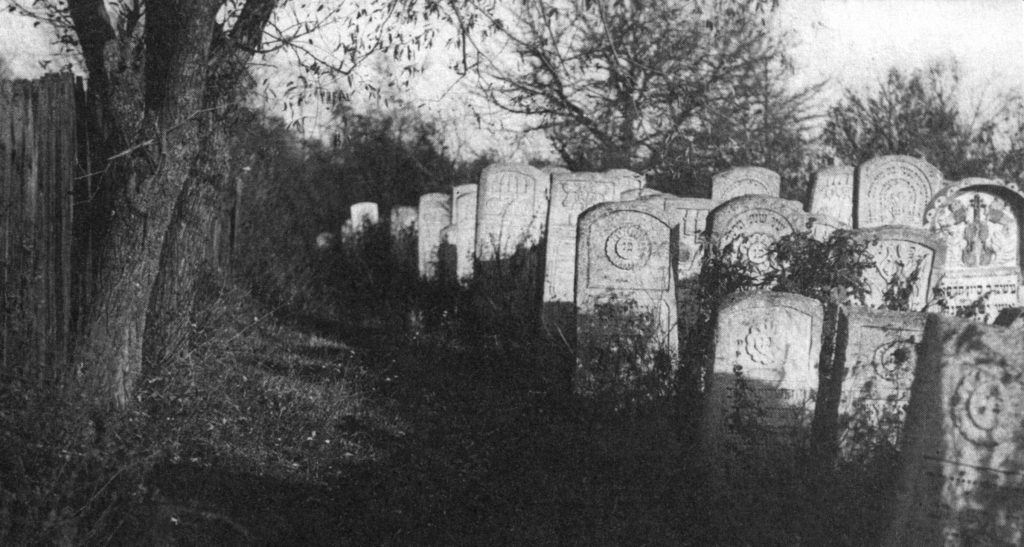
A portion of the north edge of Rohatyn’s old Jewish cemetery, from a postcard image dated 1917. A matzevah with a violin and two lions is shown at the far right of the image. Photo in the public domain; image from the extensive archive of pre-WWI photographs assembled by Tomasz Wiśniewski.
There are two photographs of Rohatyn’s old Jewish cemetery in Tomasz Wiśniewski’s 2009 book “The Lost World of Small-Town Jewish Cemeteries: Reconstructing Atlantis”, which draws from his extensive collection of old postcards and other sources to depict the lost world of pre-war Jewish cemeteries in Poland and western Ukraine. One of the photos, dated 1917, shows a small portion of the dense forest of matzevot which predated the cemetery’s destruction. Among those markers is one which includes a prominent violin and two lions. The violin may have indicated the grave of a Levite, or perhaps more likely that of a professional musician; Rohatyn was home to one of the more famous Jewish musical families in Galicia. This matzevah has not yet been recovered in town.
In his foreword to this important book of photographs, Wiśniewski says about all of the cemeteries documented by the images, “These have one thing in common – not the slightest trace remains of them.” But more clearly now in Rohatyn, some years since the book was published, small traces do remain, and more are being unearthed and recovered every year. Perhaps the Jewish poetic epitaph opening “here is hidden” is relevant to the matzevot of Rohatyn also. We hope you will view this introduction as an encouraging window on both the history and the possibilities for Rohatyn’s Jewish cemeteries.
This page is part of a series on Jewish Culture in Rohatyn and beyond.
Sources
YIVO Encyclopedia of Jews in Eastern Europe: article on Tombstones
Jewish Encyclopedia; Isadore Singer, ed.; Funk & Wagnalls Co.; New York, 1901-1906; online edition: articles on Tombs; Tombstones
The Lost World of Small-Town Jewish Cemeteries: Reconstructing Atlantis; Tomasz Wiśniewski, with a foreword by Ruth Ellen Gruber; Instytut Wydawniczy Kreator; Białystok, 2009.
Carved Memories: Heritage in Stone from the Russian Jewish Pale; David Goberman, with an introduction by Robert Pinsky and an essay by Gershon Hundert; Rizzoli International Publications; New York, 2000.
Prague Jewish Cemeteries (Pražské židovské hřbitovy); text by Arno Pařík and Vlastimila Hamáčková; photos by Dana Cabanová and Petr Kliment; Židovské muzeum v Praze; Prague, 2008.
Wikipedia in English: articles on Matzevah; Ohel; Menorah
Wikipedia in Ukrainian: articles on Мацева; Сатанівський єврейський цвинтар
(Candle)sticks on Stone: Representing the Woman in Jewish Tombstone Art; articles on:
– Candlestick Types
– A stone-carver’s thoughts on tradition and symbolism
– When did candlesticks become standard shorthand for denoting a woman?
– More Thoughts on Candlestick Typology
– Winged Heads
and photo galleries on:
– Candlesticks in Ukraine
Jewish Heritage Europe: articles on:
– Jewish gravestones and the stone-carvers who made them
– Women Remembered in Jewish Ritual Art
and photo galleries on:
– Hands in Priestly Blessing
– Flowers in Jewish decorative art
– World War I – Memorials to Fallen Jewish Soldiers
Blood and Frogs: Jewish Genealogy and More; article on Jewish Gravestone Symbols
JewishGen: article on Reading Hebrew Headstones
Reading Hebrew Matzevot Key Words, Abbreviations, & Acronyms; Ron Doctor; self-published; Portland, 2008. Posted to RootsWeb on Ancestry.com.
Samuel Gruber’s Jewish Art & Monuments: article on Concrete Tombstones, The “Poor Cousins” of Matzevot Typology
kirkuty.xip.pl: article on Kilka słów o cmentarzach żydowskich i obyczajach związanych z pogrzebem
Virtual Shtetl: article on Funerary Symbolism
Jewish Epitaphs; articles on Tombstones; Epitaphs


